When it comes to hardware innovation, nothing has quite changed the game over the past decade quite like grooveboxes.
Just look at some of the best hip-hop and electronic music producers of recent, and we guarantee you'll see some sort of groovebox in their setup. Personally, there's no other piece of gear I've yet to come across that is able to combine various sounds and samples, allowing me to take small ideas and turn them into full-fledged compositions.
Of course, with seemingly infinite options on the market today, trying to find a quality groovebox for your needs can feel like a daunting process.
Luckily, you've come to the right place! Today, we're going to dive in and explore some of the best grooveboxes for music production in 2023 and help you find the one most suitable for your needs.
Let's dive in!
What Is a Groovebox?
A groovebox is a piece of outboard gear or electronic musical instruments that combines a wide range of sound sources into a singular device. They're essentially designed to make the production experience more tactile, giving music producers a user-friendly interface to create melodic and rhythmic patterns with their hands rather than by clicking out MIDI patterns on their computers.
Over the past decade, they've become integral among electronic music producers, DJs, and live performers.
Most grooveboxes include built-in effects and sampling capabilities as well, pushing the boundaries of what's possible with hardware instruments.
The beauty of grooveboxes is that you don't need additional software to make music if you don't want to use it. This is because they essentially have software built-in.
Why Are Grooveboxes Essential in Music Production?
It almost seems as if grooveboxes became a staple overnight. And if you're wondering why you might consider adding a groovebox to your hardware setup, consider these few benefits:
- Convenience: For starters, grooveboxes are completely self-contained. These ultra-compact units combine a wide range of sound sources, allowing you to take them with you on the go and make music anywhere you are with ease. Beyond power, they don't require any additional equipment or software. Simply plug them in with a pair of headphones or monitors and you're good to go!
- Versatility : You can do just about anything with a groovebox, and with so many different sounds and features built-in, the creative possibilities are near endless. The speed at which you can bounce from one instrument to the next, banging out rhythmic patterns and manipulating melodies, is pretty astounding. I have yet to find a more innovative instrument.
- Performance: You'll often see DJs and music producers take their grooveboxes to the stage, as they are designed for live performance. There's nothing quite like a groove box for creating ultra-complex compositions on the fly. While grooveboxes can vary in terms of features, they often include real-time parameter manipulation, making a far more expressive and tactile performance experience.
What to Consider When Looking for a Groovebox
There are several things to consider when looking for the right groovebox. Here are a few factors to help you narrow down your options!
Sound Quality
Though it might seem quite obvious, one of the most important factors to consider when looking for a groovebox is the sound quality .
At the end of the day, your ultimate goal is to create music that people enjoy.
So, you might be asking,
How in the world do I evaluate the quality of a piece of equipment like this?
For starters, consider the overall clarity of the groovebox in question.
Does the groovebox offer quality samples?
How do the samples sound when coming out of it and into your headphones or speakers?
Does it have synthesis capabilities that allow you to create sounds from scratch?
If you're someone that likes to tinker, this could be a significant consideration!
Lastly, you'll want to pay attention to characteristics such as dynamic range and noise levels.
As our music becomes more and more synthesized, more and more producers are looking for ways to make their performances more dynamic. Your groovebox should be able to recognize your attention to detail as you tap away at different speeds and velocities. The sound that comes out should also be crisp and clean without any underlying noise (or at least very little noise, depending on whether or not you're going for an analog vibe).
Features and Capabilities
Beyond your groovebox's sound quality, you'll want to consider its capabilities.
Some groove box manufacturers focus solely on sample manipulation and sequencing, while others offer advanced synth engines, which allow you to process your samples with modulation and effects.
However, in my experience, there are two overarching characteristics I recommend looking for:
- Sequencing capabilities
- Sampling capabilities
Let's start with your groovebox's ability to sequence .
If you've never used a step-sequencer before, it can be difficult to know what separates a robust one from a basic one.
At its most basic, a step sequencer allows you to program musical patterns to a grid. This is likely the level of capability you'd find on an old drum machine from the 80s. Essentially, you can program drum patterns and adjust characteristics like timing and velocity on a smaller grid (typically anywhere from 16 to 32 steps).
On the other hand, more advanced step sequencers offer things like multiple sequencing lanes, allowing for layered composition, as well as advanced editing tools like automation, swing , or syncopation .
The level of flexibility you get with one of these units typically correlates with the price, so expect to spend more for a higher level of flexibility.
Beyond its sequencing capabilities, you'll want to consider whether or not your groovebox of choice has a decent sampling engine.
Many modern grooveboxes have as much sampling flexibility as a DAW these days, meaning you can load up your own samples and process them to your heart's content with seemingly infinite sound manipulation tools.
From slicing up drum grooves to resample individual elements to time-stretching vocals to resample them within a project of a different tempo , the possibilities are endless.
User Interface
Most producers buy grooveboxes to speed up their workflow, so if yours feels like it hinders your capabilities or slows you down, it might not be the groovebox for you.
The interface should feel seamless and easy to navigate. Of course, as with any piece of equipment, there will be a learning curve, though that curve shouldn't be so steep that it hurts its functionality.
All of the crucial parameters should be easily accessible, from the more tactile portions of the interface, such as the knobs, buttons, or faders, to the more navigation-oriented features, such as the menus and settings.
This is where having a groovebox with a high-quality visual display comes in handy. I like to be able to see the settings I'm adjusting in real time, especially when performing in low-light situations.
Lastly, if your groovebox isn't functional for your workflow needs right out of the box, the next thing you might ask is whether or not you can make adjustments in the settings so that it gels with your needs.
Can you reorganize functions and controls, so they better fit your workflow?
Can you personalize or make menus as favorites, so you don't have to jump through a million hoops each time you want to make changes?
Portability
If you're looking to make music on the go or take your groovebox to the stage, you'll want to consider portability.
You might consider looking for a groovebox that you can throw in your backpack when you're ready to hit the road. So, not only will you need to consider the dimensions of your groovebox, but also the weight .
Beyond the structural layout, consider what you need to power it.
Some grooveboxes require nothing more than a few AA batteries to get up and running, while others require some form of bus power, meaning you'll need to have them plugged into a desktop computer or laptop.
Some require so much power that you'll need to be next to an outlet whenever you want to use them.
These are major considerations to make, depending on where you plan on playing.
Price
How much are you willing to spend on a groovebox?
A decent groovebox will run you a few hundred dollars. On the other hand, you could end up paying well over a thousand dollars for a top-of-the-line unit with all the latest and greatest features.
While your budget should never be the end-all deciding factor for any piece of gear that's an investment, getting something that gives you the best value for your money is crucial.
Your best bet is to consider your needs . If you're just starting out, go for a budget-friendly groovebox and get comfortable with using it before you step up to one with more complex features and capabilities.
Different Types of Grooveboxes
Note that there are also different types of grooveboxes you might consider, each of which has unique features and design characteristics:
Sampling Grooveboxes
If you like the idea of going the organic route with your music, you might consider getting a sampler groovebox. The beauty of these grooveboxes is that you can record and manipulate your own audio. These grooveboxes come with built-in microphones or the ability to attach a microphone or audio cable via an XLR or quarter-inch input, as well as a number of sampling manipulation tools, so you can slice, dice, shift, and stretch your audio.
Synthesizer Grooveboxes
Synthesizer grooveboxes are geared toward electronic music producers. You'll often find built-in drum machines, synthesizers, and effects engines, as well as advanced step-sequencing capabilities.
Modular Grooveboxes
Modular grooveboxes are just as they sound - grooveboxes that allow the user to configure them in any way they desire.
These are some of the most functional and versatile grooveboxes, as they allow you to patch together unique modules, depending on your needs. For example, you might want a groovebox with a few oscillators, some analog-style filters, and a 16-step sequencer. Essentially, the level of control you get is up to you.
Of course, with greater customization typically comes greater complexity, so these are best reserved for those who are already familiar with grooveboxes.
Mobile Grooveboxes
If you're an on-the-go music producer, consider getting a mobile groovebox. These are more lightweight and compact than your average groovebox, and often utilize battery-powered designs to keep you from needing to find a wall outlet every time you want to perform.
Just like most full-sized grooveboxes, you'll often find built-in microphones for recording live audio and headphone outputs for monitoring. Some of the higher-end mobile grooveboxes even come with wireless Bluetooth connectivity, allowing you to import audio files without the need for any wires, which is pretty awesome if you're making music on the road.
Of course, with smaller sizes, the functionalities might be a bit limited. For example, you might not get as many steps on your sequencer, pads on your drum machine, or clarity on your LCD screen.
However, if convenience and portability are two priorities for you, you can't go wrong with a mobile groovebox!
Top Grooveboxes for Music Production
1. Elektron Syntakt
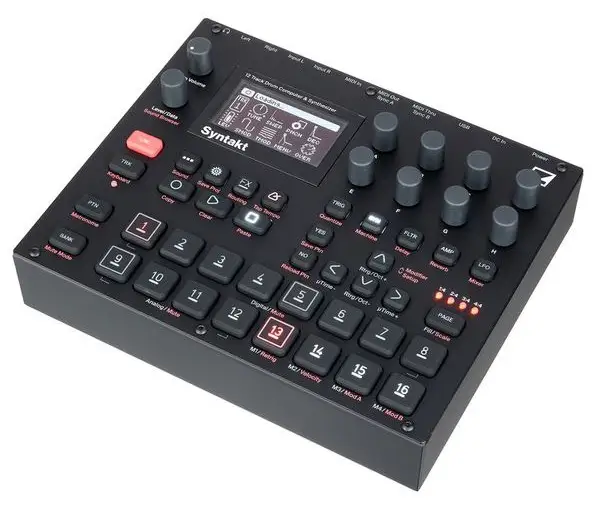
The Elektron Syntakt is probably one of the most powerful grooveboxes on the market today, offering some of the best sequencer and audio manipulation capabilities on the market. Plus, if you're priority lies in sampling, you'll be stoked by the wide range of built-in sounds and samples.
And while these features are incredibly robust, they are pretty ancillary compared to the synth engine, which gives you two beautiful-sounding analog oscillators and endless digital synthesis features. Any musical ideas you dream up can be mashed and mangled with a wide range of onboard effects, including distortion , reverb , delay , modulation , and more. The sound-shaping possibilities are some of the strongest I've yet to find.
As for its sequencing capabilities, Elektron Syntakt rides the line between complex and user-friendly, meaning its ability to spit out complex sequences and patterns is unmatched, yet the way in which you get there never feels daunting.
Plus, you get a few creative tools that you wouldn't find on other basic step sequencers, including conditional trigs and parameter locking.
In terms of connectivity, Elektron Syntakt is pretty flexible. You can connect with a wide range of devices through USB, MIDI, CV/Gate, and the unit is completely bus-powered, allowing you to use it on the go.
While it might have a slight learning curve for beginners, any experienced producer will find it to be one of the most flexible grooveboxes on the market today. The creative capabilities are truly astounding.
Pros
- Powerful synth engine that delivers analog circuit behavior
- Plenty of onboard effects to mess with
- One of the most advanced sequencers on this list
Cons
- A slight learning curve for newbies
2. Akai Professional MPC One
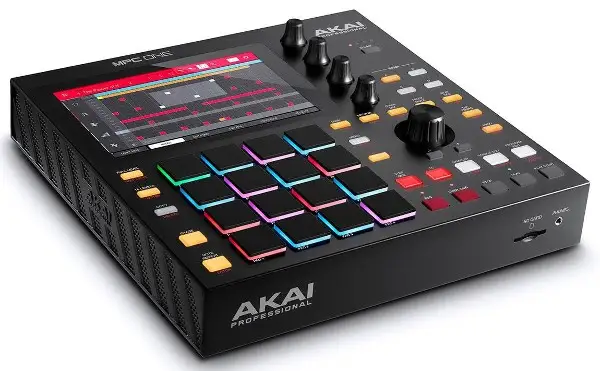
The Akai Professional MPC is one of the most powerful compact samplers and sequencers on the market today. For those familiar with the MPC X, this unit has the exact same multi-core processor, so you know what level of quality to expect. From programming beats to sampling audio to full-fledged audio manipulation using the range of onboard effects, nothing feels impossible with this Akai MPC.
Plus, with such a portable design, you can easily throw it in your backpack and take it with you on the road.
One of the coolest features the Akai Professional unit sports is the ability to use hand gestures to chop and edit your samples. You can do so using the small yet clear seven-inch touchscreen and the touch-sensitive encoders.
It's also worth mentioning that you can take your creative potential even further by linking your unit up with Akai's MPC Software 2.
There's a reason why Akai MPC has been the go-to for music production for all these years. Akai seems to be unmatched in terms of quality and durability, so if you're serious about your music production, this is one of the best options around.
Pros
- Incredibly portable piece of equipment
- High-quality sound engine
- Comes with massive library of sounds to get you started
Cons
- The screen size can feel limiting, making it hard to navigate through menus and settings
3. Polyend Play
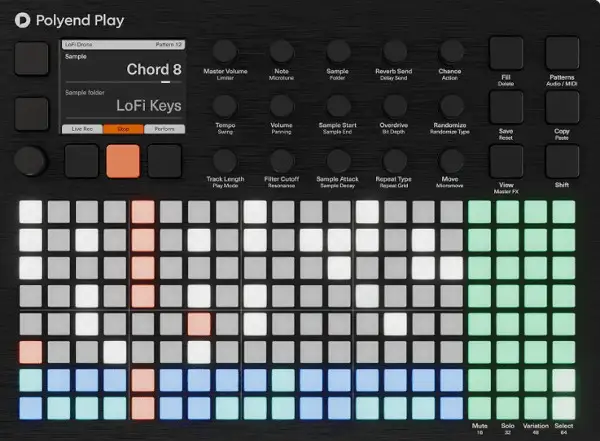
Polyend Play is very similar to Elektron Syntakt in terms of its overall capabilities. You get a ton of great sequencing and audio manipulation tools, a decent grouping of onboard sounds and samples, and a super dynamic interface for creating layered tracks with a quick workflow.
The interface might be one of my favorite things about Polyend Play, which is probably because it has an Ableton Push vibe. Right off the bat, I felt at ease in terms of navigation, never feeling like I was hopping through tons of menus to get to where I wanted to go.
Every sample loaded into Polyend can be thrown through the step sequencer from the drums to the synths and beyond. Similar to Syntakt, you get powerful sequencing capabilities, such as micro-timing and parameter locking, giving you an incredible amount of control over the sound.
Lastly, I love the feel of this device. The knobs and faders feel sturdy and smooth, and the velocity-sensitive pads are some of the most dynamic I've played around with, making for a quality tactile experience.
Pros
- Interface is very easy to navigate
- Comes with more than 3,000 samples
- One of the most advanced step sequencers on the market
Cons
- Relatively limited onboard storage compared to some grooveboxes
4. Roland MC-707 8-Track Groovebox
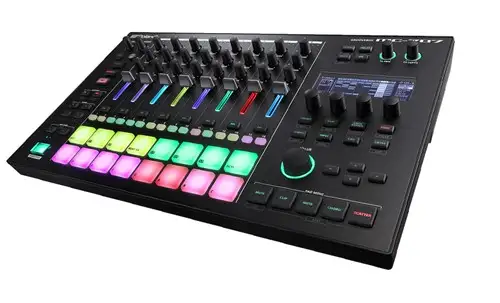
The Roland MC-707 8-Track Groovebox definitely feels limited compared to the other two above, though when it comes to portability, it's a great choice. You get eight MIDI sequencing tracks and onboard audio recording, allowing you to take your music production on the go.
Loaded into the groovebox is a wide range of loops, sounds, samples, and phrases, which you can play and manipulate using the 16 velocity-sensitive pads.
It's worth noting that everything that goes into the Roland MC-707 8-Track Groovebox is stored on an SD card, meaning you don't get the best storage. If you're recording the high-quality audio that it allows for (32-bit/96-kHz), it's easy to run out of storage pretty quickly.
However, if you're looking for solid sequencing capabilities and quality sound in a small, affordable package, it's one of the best groovebox units on the market.
Pros
- Surprisingly advanced sequencing capabilities with only eight tracks
- Comes with 3,000+ built-in sounds and samples
- Very solid and sturdy feel, perfect for the on-the-go music producer
Cons
- Small screen can make it difficult to navigate
5. Novation Circuit Tracks Groovebox
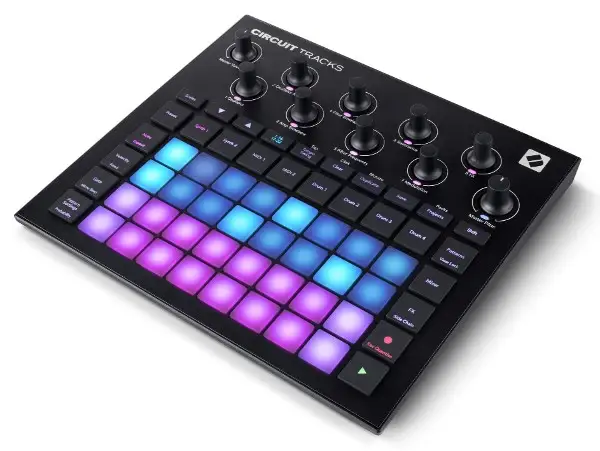
One of my other favorite budget-friendly options is the Novation Circuit Tracks groovebox, which offers one of the most affordable and portable ways to build entire tracks without a DAW. Novation has long been a standout gear manufacturer, and at this point, they have a few standalone groovebox options to pick from.
Circuit Tracks, in particular, features two MIDI tracks, four drum tracks, and two polyphonic synthesizers.
One of my favorite features is the ability to lock your synth engine into a specific key, so you don't accidentally play a bunch of embarrassingly wrong notes on stage. It's great for getting creative without ever having to worry about falling out of key.
With the Synth Micro-Nudge setting, you can move your music off the grid, or create spacey drones using the tie-forward feature. The complex capabilities feel infinite with this colorful little box.
One thing to note about the Groovebox is that it uses a rechargeable lithium-ion battery, allowing you to take it with you on the go and play anywhere your heart desires. On the back, you'll find both USB and MIDI connections, allowing you to sync up to your other gear for solid compatibility.
You get true freedom with the Novation Circuit Tracks Groovebox, with plenty of great editing features and live performance features, great for modern music production and real-time composing.
Pros
- One of the most compact and lightweight devices on the market today
- Completely standalone groovebox with a built-in rechargeable lithium-ion battery
- Surprisingly versatile sequencer capabilities
Cons
- Limited internal storage with only 60 seconds of available sample time
6. Native Instruments Maschine
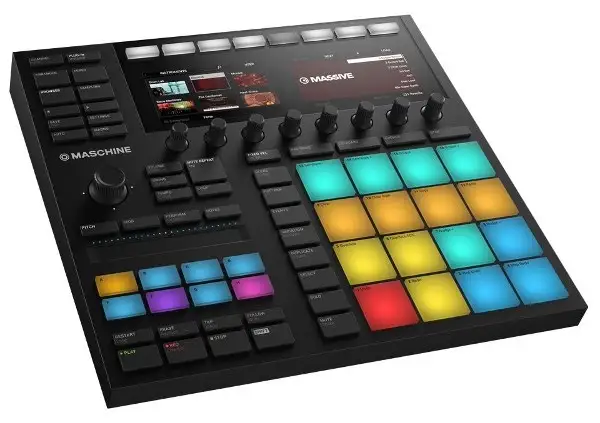
Native Instruments is one of the pioneers in VST development, and with their massive library of software sounds and effects comes a physical reincarnation of a digital MPC.
One of the biggest pitfalls of Native Instruments Maschine is the inability to use it as a standalone groovebox. However, as a modern music production workstation, it allows you to take advantage of just about every feature you could think of from the Native Instruments realm.
You'll find a robust set of features, plenty of top-notch instrument expansions, innovative sync features with both third-party and NI products, and one of the most supportive development teams in the industry, perfect for troubleshooting down the line.
The latest iteration of Maschine, the MK3, comes with a built-in sound card, which makes the setup process far simpler than ever before. Plus, I love the ability to use third-party VST libraries, as I never feel limited to what's available in the NI sphere.
Pros
- The MK3 iteration offers some of the most flexible sampling capabilities on the market, allowing you to sample directly from your hardware or software
- Comes with a high-resolution color display that offers excellent visibility
- High-quality, velocity-sensitive pads with excellent response
Cons
- Does not offer standalone functionality
7. Roland AIRA Compact T-8
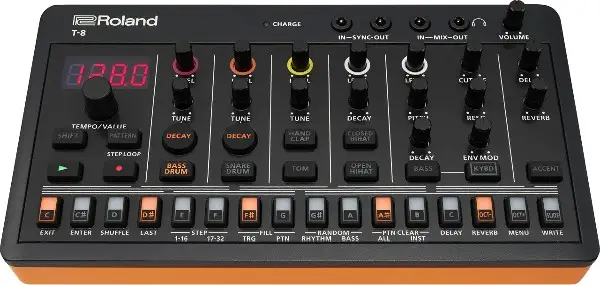
Many people refer to this little unit as the Roland "Beat Machine." Beyond its capabilities as a standard groovebox, the bass section is modeled after the iconic TB-303, giving you that gritty, acid-house tone that'll instantly transport you back to the hazy days of 90s raves.
What's unique is that Roland decided to take a hybrid approach to the drum machine portion of the groove box, giving you slight similarities to some of the company's vintage drum machines with a bit of modern flavor.
Of course, any drum machine aficionado will be able to pick out the fact that the snare and bass drum were ripped from the TR-909, the claps were take from the TR-808, and the toms almost sound like the TR-606 and 808 had a baby. However, with additional flams, sub-steps, and velocity capabilities, the level of flexibility is much greater than ever before.
Similar to the built-in drum machine, you can employ X0x step-time programming to create basslines or use the buttons as a "keyboard."
While it might not have the same level of flexibility as other grooveboxes on this list, the T-8 is tons of fun to use and has just enough functionality to hold its own on this list.
I love the fact that the company decided to add the ability to randomize bass and rhythm patterns, or add variable probability to every step in the drum machine sequencer, as it moves the T-8 away from the standard analog reissue ordeal we've been seeing lately.
What it lacks in terms of a display and menu system, it makes up for in the quality of its sound engine and portability.
Pros
- With Roland's Analog Circuit Behavior technology, you get the sweet analog sounds from classic Roland drum machines
- Very intuitive interface
- Small and lightweight, making it easy to transport and integrate into different setups
Cons
- Limited sequencing options
8. Korg Electribe Sampler
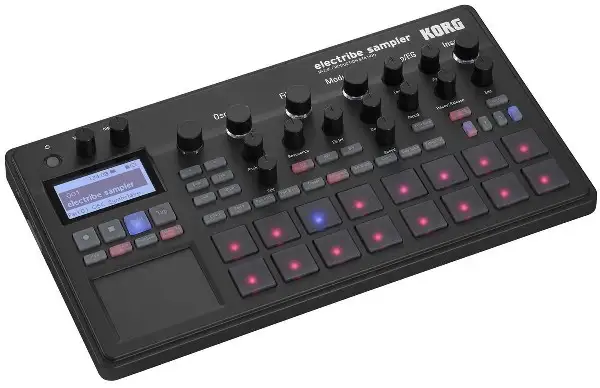
Korg has finally stepped into the groovebox world with Electribe, and we couldn't be happier. For starters, you get the option to import or record your own audio, allowing you to build tracks in whatever way you see fit.
What I didn't expect to find when I first popped this thing open was so much integrated content. The Electribe Sampler provides more than 400 drum samples, stabs, melodic hits, loops, phrases, and more.
Even with its relative flexibility, getting up and running with Electribe is a pretty easy process. You can start by sampling your own sounds by importing them from external sources or recording your own samples directly to the device via the built-in audio interface . There are plenty of built-in effects, including distortion, reverb, and delay, which you can apply to individual samples or your entire internal mix, essentially giving you a DAW on the go.
Where Korg might fall a bit short is the storage. Some users might not like having to save new samples to an SD card.
However, if on-the-move flexibility is your priority, it's an excellent piece of equipment for all styles of electronic music production.
Pros
- Plenty of great built-in sounds and effects
- Has the ability to export to Ableton
- Very user-friendly interface
Cons
- You have to save new samples to an SD card
Final Thoughts
If you've been making electronic music for more than a few years, you've probably noticed the constant state of evolution attached to gear. And with the ever-expanding nature of electronic music comes the need for versatile production tools.
From Akai to Roland to Novation, there are so many great manufacturers putting out grooveboxes, that in the end, the best thing you can do is roll down to your local music store and test them out to see which one feels best to you.
I've found that adding a groove box into my setup has been an absolute game-changer for my creativity and workflow, and I couldn't recommend getting your hands on one of these things more!





